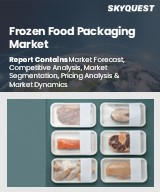
세계의 냉동식품 포장 시장 규모는 2023년에 314억 달러로 평가되었고 예측기간(2025-2032년)의 CAGR은 5.9%로, 2024년 332억 5,000만 달러에서 2032년에는 526억 달러를 나타낼 전망입니다.
도시 소비자들의 간편한 즉석식 수요 증가와 식품 보존 및 유통기한 연장에 대한 인식 제고로 세계의 냉동식품 포장 시장은 상당한 성장을 경험하고 있습니다. 소비자들의 환경 의식이 높아짐에 따라 재활용 가능하거나 재사용 가능한 포장재로의 전환 추세가 가속화되고 있습니다. 콜드체인 물류 및 기술 발전 역시 제품 품질, 안전성 및 매력도를 향상시키고 있습니다. 도시 생활이 더욱 빠르게 변화함에 따라 냉동 식사는 일상생활에 점점 더 통합되고 있으며, 안전성 향상을 위한 유통기한 연장에 중점을 두고 있습니다. 그러나 고급 포장재의 높은 비용, 특정 지역에서 지속 가능한 대안에 대한 지식 부족, 부적절한 재활용 시스템, 엄격한 식품 안전 규정과 같은 과제들은 시장 확장을 저해할 수 있습니다.
Global Frozen Food Packaging Market size was valued at USD 31.4 billion in 2023 and is poised to grow from USD 33.25 billion in 2024 to USD 52.6 billion by 2032, growing at a CAGR of 5.9% during the forecast period (2025-2032).
The global frozen food packaging market is experiencing significant growth driven by urban consumers' demand for convenient ready-to-eat meals and increased awareness about food preservation and shelf-life extension. The trend towards recyclable or reusable packaging materials is gaining momentum as consumers become more eco-conscious. Advances in cold chain logistics and technology are also improving product quality, safety, and appeal. As urban lifestyles become more fast-paced, frozen meals are increasingly integrated into daily routines, with a focus on longer shelf life for enhanced safety. However, challenges such as high costs for advanced packaging materials, limited knowledge of sustainable alternatives in certain regions, inadequate recycling systems, and stringent food safety regulations could potentially hinder market expansion.
Top-down and bottom-up approaches were used to estimate and validate the size of the Global Frozen Food Packaging market and to estimate the size of various other dependent submarkets. The research methodology used to estimate the market size includes the following details: The key players in the market were identified through secondary research, and their market shares in the respective regions were determined through primary and secondary research. This entire procedure includes the study of the annual and financial reports of the top market players and extensive interviews for key insights from industry leaders such as CEOs, VPs, directors, and marketing executives. All percentage shares split, and breakdowns were determined using secondary sources and verified through Primary sources. All possible parameters that affect the markets covered in this research study have been accounted for, viewed in extensive detail, verified through primary research, and analyzed to get the final quantitative and qualitative data.
Global Frozen Food Packaging Market Segments Analysis
Global Frozen Food Packaging Market is segmented by Material, Packaging Type, Food Type and region. Based on Material, the market is segmented into Plastic, Paper & Paperboard, Aluminum and Others. Based on Packaging Type, the market is segmented into Rigid and Flexible. Based on Food Type, the market is segmented into Fruits & Vegetables, Ready-to-eat Products, Dairy Products, Meat, Poultry and Seafood, Bakery & Confection and Others. Based on region, the market is segmented into North America, Europe, Asia Pacific, Latin America and Middle East & Africa.
Driver of the Global Frozen Food Packaging Market
The Global Frozen Food Packaging market is significantly influenced by the growing demand for convenient meal options. As consumers lead increasingly busy lifestyles, particularly in urban settings, there is a shift toward ready-to-eat frozen foods that require minimal preparation. Effective packaging plays a vital role in preserving product freshness, extending shelf life, and ensuring food safety during storage and transport. This trend is particularly pronounced in dual-income households, where the need for time-efficient meal solutions is becoming more prevalent. As a result, the frozen food sector is experiencing a notable transformation driven by the desire for quick and accessible dining experiences.
Restraints in the Global Frozen Food Packaging Market
A significant limitation facing the global frozen food packaging market is the elevated expense associated with the incorporation of advanced packaging materials and technologies, which can render these products unaffordable for a large segment of consumers. While there is a growing demand for sustainable packaging alternatives, these options typically come at a premium compared to conventional plastic-based solutions. Enhancements in packaging, such as developing barrier films for fresh fish, creating recyclable laminates for tinned products, and implementing sophisticated sealing technologies like double-sealing and lidding devices, contribute to increased costs and may hinder wider adoption within the market.
Market Trends of the Global Frozen Food Packaging Market
The Global Frozen Food Packaging market is experiencing a dynamic shift driven by innovations in packaging solutions aimed at enhancing consumer experience. Manufacturers are prioritizing superior quality, safety, and convenience through the experimentation of new materials, technologies, and designs. Advances such as high-quality films and laminates offer improved insulation and protection against moisture, air, and odors, effectively preserving the integrity of frozen food products. Additionally, techniques like vacuum sealing and modified atmosphere packaging are gaining traction, as they significantly extend shelf life while reducing spoilage and food waste. Packaged solutions that enable microwave and oven use streamline meal preparation, catering to the fast-paced lifestyles of consumers and shaping the future landscape of frozen food packaging.